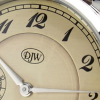-
Recently Browsing
- No registered users viewing this page.
-
Topics
-
Posts
-
I’ve been working on a 7750 with some success - so far not broken or lost anything and have the base movement up and running well. I’ve reassembled the chronograph mechanism and I have a problem with the minute recording. The finger on the centre wheel is at the wrong angle - it hits the minute driving wheel and the watch stops, unless I give a little nudge and then it carries on. The tech sheet says to check for 0.02mm clearance (figure B) which I haven’t got. Can I adjust the finger on the chrono wheel, or should I get a replacement? Is there anything else to consider?
-
Yesterday a Rolex cal. 3135 landed in my hands housed in a Rolex Oyster Perpetual Date reference 15200. Having analysed its running (fully wound) using @praezis excellent PCTM software, nothing is alarming or acute, nevertheless, my conclusion is that it's up for and could benefit from a service. I'd like to know if someone has a different opinion. Pictures to follow... However, what is alarming is that the rotor is loose, and unfortunately, I think it's pretty bad as the rotor won't even oscillate when the watch is in a dial-down position and gently shaken. It also makes an unpleasant metallic sound when the rotor is spinning, so I hope it hasn't caused too much damage. Unfortunately, I have not been able to confirm this visually as I do not have the correct tool to open the case back and do not want to take chances with my JAXA opener. No doubt a repair is needed, and if a repair is done a service should of course be done as well. I guess I just answered my question 🤨 After reading this thread started by @dibs1, I guess that the rotor axle is worn out and needs to be replaced. dibs1, you mention that you replaced it "using the proper staking punch". It would be interesting if you (or someone else!) could tell us a bit more about how that operation is done. I also read somewhere that "There is a brass 'bearing' or similar, in the movement that wears out and starts to leave brass shavings in the surrounding around". I have no doubt that I would be able to carry out a service but I feel a little unsure about how advanced the rotor repair is and what tools are required. So any handy tips would be greatly appreciated!
-
Hello, I am French and Canadian, based in Montreal for 11 years now. I am a watch addict, specially vintage watches or watches with an history. I have always been fascinated by the ingenuity of watch movements and I have decided recently to learn more about them by taking Mark's courses on watchfix.com I will certainly learn a lot from you all, I am therefore looking forward to participating in this forum.
-






Recommended Posts